Written by Dr. Lindsey Williams for the RSDSA blog.
Imagine living in fear of losing your ability to live, to have a life. A very wise friend once told me to live life, and always work towards making my dreams come true. Life is about doing what you love. Since recovering from my first experience with Complex Regional Pain Syndrome (CRPS), I have been determined to achieve my dreams.
In the silence and stillness of my mind, the pain sneaks back in. I strive hard to keep busy so that there is no room for pain. Even the slightest tingle, ache, or burning sensation in my foot brings back horrific memories and fear of the unknown. My thoughts race. Do I need to call my pain doctor? Oh God, what if it is coming back? I just cannot do it again. I always carry a bottle of my Gabapentin with me. I never leave home without it just in case. Imagine living every day like this. I am not sharing these things for sympathy or pity. I do not want either, but what I really want is support for people like me who suffer from CRPS and chronic pain.
Many people, including healthcare professionals, do not really understand chronic pain. I have to be perfectly honest, I really did not understand real pain until I went through this. The American Academy of Pain Medicine estimates that a staggering 100 million Americans are suffering from chronic pain.
A rite of passage is defined as an event marking an important stage in someone’s life. My rite of passage was a time of suffering, loneliness, and loss. I lost myself in the medications and pain, and even though I saw my family daily and my friends frequently, I was isolated because no one understood what I was going through. I believe as humans we need something external for people to see to believe that you are “sick.” The thing about chronic pain is that you don’t “look sick,” other than the dark circles and the fake smile. You cannot see or touch chronic pain. What people cannot see are the long-reaching tentacles of this disease whittling away at your spark for life. So many times people asked how I was doing. What can you really say? I am not sure they could have handled or understood the truth. I was exhausted, and my foot was on fire but there were no flames or smoke to be seen. I had become the master of being okay. It is hard for people to understand what they cannot see.
I am surviving with CRPS. I hear people say, “I can’t go on,” “I’ll never be better,” “I just want to die.” At one point in my life I thought about all of those things. I wanted to disarticulate the lower half of my left leg from my body to stop the pain. I am here to tell you that you can survive and that you can be better. I felt like a failure as a wife, mother, friend, and co-worker. I was physically and emotionally ravaged. The CRPS had taken everything from me. I was in rigid denial about my CRPS; for two years I did not want to talk, think, or hear anything about CRPS after I was better. In my mind, it was behind me, but if I talked about it, somehow it would creep back into my life. Eventually, I was able to reconcile my pain, grief, loss, and regret, and understand that my suffering was the price of admission to a meaningful life. The adage “you don’t miss something until it’s gone” is so true. There was a time that I thought I would never be able to walk, work, or have a normal life again. It is not that I needed my experience of suffering, survival, and remission to be a secret. I thought sharing it would give others an unrealistic expectation of recovery, and I feel guilty that I beat the odds.
What was revealed to me through my pain and suffering was the gift of self-awareness and the importance of being present and a part of life. I had been shaped into a tougher version of myself. Twenty months after it all started, I had regained some aspects of control. I would not say recovered because that would indicate completion of my journey, which in fact is untrue, I will be a better version of myself. I learned that I am tougher than I thought. I was at the bottom of the barrel; I climbed out and knocked that barrel over and set it on fire. I will never be that person again.
I am not an expert in all types of chronic pain. However, I am an expert on the survival of CRPS which is also called the suicide disease. CRPS is so different from other types of chronic pain but the general principles are the same, it sucks. I believe with my heart and soul that everything happens for a reason. Looking back now, my entire outlook on life has changed. Things I used to take for granted, I now hold near and dear to my heart. For example, vacuuming my house, going to the grocery store, walking, or being able to help my family. We do not always know why things happen, but I would like to make something good out of what I survived.
The human body is made up of the tiniest living organisms. Those organisms form cells, tissues, organs, and systems. Our body is an amazing machine, even to the finite detail of the sodium-potassium pumps (which still fascinates me) that work within our cells to keep things running smoothly and balanced. Like any machine, sometimes things can be connected incorrectly or mis-fire. Our autonomic nervous system controls all things that happen “automatically” like breathing, digestion, and your heartbeat. It also keeps our sympathetic nervous system, which is your “fight or flight” response in check. It is great that we have the flight or fight response when we need it. It can save your life. Imagine if you had to continually live with the fight or flight response uncontrolled. It would wreak havoc on your mind, body, and soul. For a period of two years, I lived with a malfunction in my nervous system that involved my left foot and leg.
I had what they call an unstable left ankle. For as long as I can remember, I had a fear of falling or twisting my ankle. On multiple occasions, I would just be walking, and my ankle would roll on me. One of the worst falls happened when I was walking on the riverwalk in San Antonio carrying my two-year-old son Jesse and we fell down some stairs. Thankfully he was okay. The fall that changed it all occurred in September of 2012 at an anesthesia conference in Boston. I broke my ankle while on the subway train. Bones heal with time, but sometimes the ligaments, tendons, and nerves that have been repeatedly stretched over time lose their ability to function as designed.
Let me just preface this by saying, when I decide to do something, I do it come hell or high water. I planned, and God laughed. In June of 2013 a co-worker that serves in the Navy Reserves informed me that the Navy was recruiting for pediatric anesthesia providers. I thought this would be an awesome opportunity to serve my country, do a job that I love, and help kids in need. I jumped through all the hoops and all my paperwork was approved. All I had left was to pass the physical exam that involved running. I had already completed a three-month round of P-90X and joined CrossFit prior to knowing about the Navy’s physical requirements. My ankle was hanging in there, but it was more unstable and painful after this last fracture and running was no fun! My ankle had become an inconvenience, it was time to do something about it. I made an appointment with our foot and ankle surgeon. He suggested bracing for a while to see if it would help strengthen the ligaments or at least keep me from twisting or breaking it anymore to avoid surgery. After a few months of daily bracing with no improvement in my ligament’s strength, we decided to go ahead with a surgery called the Brodstrom procedure on my left ankle. I had surgery on May 8th, 2014. Over 40 years, I have lost count on the number of times I had “sprained” my ankle, but each time it was worse than the time before and it took longer and longer to heal. When the surgeon told my husband it was the worst case he had seen, I was not surprised.
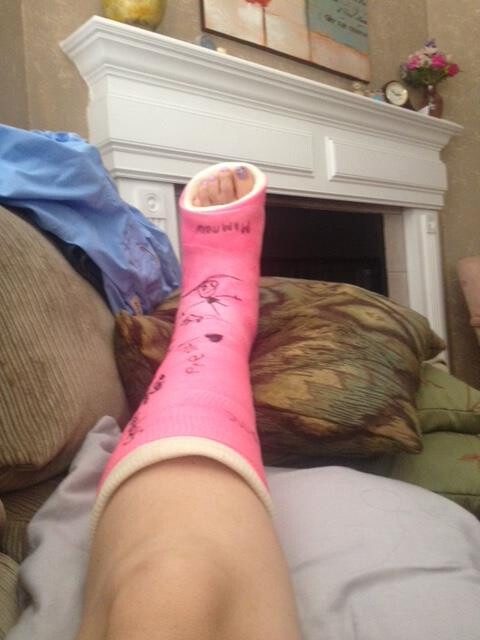
On May 22, 2014, I went for my follow-up appointment. The splint removal which involved cutting and removing the soft cotton wrap was tolerable. However, when we got to the suture removal, that was a different story. I could feel every nerve in my foot. It was like they were all screaming in agony at the same time. The pain was unbearable shattering pain. I needed a leather strap and a bottle of whiskey. I thought I might die; my heart was beating so fast, I could not breathe. Just the touch of the medical assistant’s hand on my foot sent me reeling in pain. The problem was I still needed a cast, but I could not stand for anyone to touch my foot and it was very swollen.
Within a few days, the cast had to come off one way or another. I was going to cut it off myself if I could not see the doctor. My toes would be likened to purple Vienna sausages. Even when I was pregnant, my feet were never this swollen. When we finally got the cast removed the vibrations from the cast cutter hit every nerve in my foot sending a million pain signals to my brain. All I could say to myself was “this is not supposed to hurt” and my brain was overwhelmed with emotions and pain; I vomited. I just wanted them to amputate my foot while they were cutting the cast off. You know the feeling when your arm or leg falls asleep and it starts to “wake up”. It is that feeling amplified exponentially while on fire.
I composed myself in time to speak to the doctor. I just could not wrap my head around why this hurt so badly and why my foot was so swollen. You know it is never good when the doctor starts the sentence with “I’m sorry.”
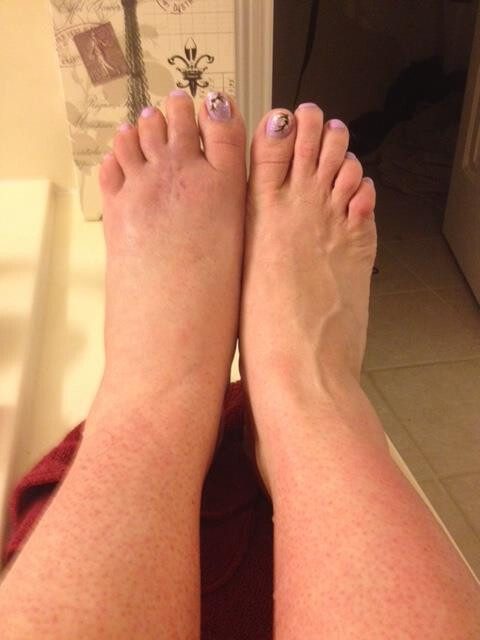
The first time I heard the words Complex Regional Pain Syndrome (CRPS), my first thoughts were, how are we going to stop the pain and what is CRPS?
There are no blood tests for CPRS. It is diagnosed by symptoms. Immediately I began a Google search, and Dr. Google can be terrifying. My doctor suggested that I try Gabapentin to see if it would help with the pain and swelling. Gabapentin or Neurontin is an oral medication used to treat nerve conditions. I was ready to try anything. It had only been a few weeks and I was ready to disarticulate my foot from the rest of my body. Within 45 minutes of taking my first dose of Gabapentin, the pain subsided. We all hate the unknown; not knowing what is wrong with you or a loved one is awful, but the diagnosis of CRPS was one I never thought I would hear. My original dose was 300 mg every six hours. For a few days that stopped the pain but as time went on, we had to increase the dose to the point where it was not working anymore. We determined I had CRPS type II because I had all the classic symptoms. CRPS occurs when the nervous system and the immune system malfunction as they respond to tissue damage from trauma. The nerves misfire, sending constant pain signals to the brain. To be completely honest, I had no real idea what CRPS was. I remember hearing about it in anesthesia school, but thankfully we do not see it much in kids. I remember reading all the symptoms associated with CRPS and trying to explain to family, friends, and co-workers what I had. A million things go through your head while you try to comprehend what was happening. My surgeon put in a consult to the pain clinic for me to see if they could help.
I visited the pain clinic for the first time in July 2014. I had no real idea what to expect, but by this point, it had been roughly eight weeks of unrelenting pain and lots of confusion. Self-pity had set in. I asked myself, “How could this happen to me? What did I do to deserve this?” I learned that for CRPS patients, the level of pain is measured as one of the most severe on the McGill University pain scale, higher than childbirth or amputation.
As a nurse anesthesiologist, I took care of other people. I never expected to be the patient. I knew one thing walking into that clinic that I was not going to become a dreaded pain patient that you hear so many people talk about. Our pain doctors are fellowship-trained anesthesiologists in pain management. The plan in my mind was they would give me some medicine, a nerve block, and everything would be great. I had to go back to work and I had life to live so we needed to fix this, and it was that simple, or so I thought.
My personal experience with anesthesia had been limited, until my niece, Sarah had to have surgery for an infection in her chest in early 1999. I was a new mother and my husband was in the Marine Corps. I had not really decided what I wanted to be other than a wife and a mother. I remember very clearly the Certified Registered Nurse Anesthetist (CRNA) that took care of Sarah when she had surgery. He made such an impression on me that I decided to go to nursing school and become a pediatric nurse, but specifically in the intensive care unit (ICU). I became a Pediatric Intensive Care Unit (PICU) Nurse and became specially trained as an Extracorporeal Membrane Oxygenation (ECMO) perfusionist for the PICU team. I learned so much about tragedy and heartbreak in the ICU. It is not something that you ever get used to, but you learn how to compartmentalize. Amongst all the tragedy in the ICU, you also learn about hope, love, and faith. I learned over the six or so years that I was a nurse that there are a million ways our body can turn on itself and just as many ways in which the body can heal itself. In 2008, I left my local children’s hospital to begin my training to become a CRNA. I knew that I wanted to come back to pediatrics once I had completed my training. It is not that I despise taking care of adults, but there is just something about taking care of a child in need that I cannot explain. Just like taking care of adults, it is not for everyone.

Nurse anesthesia school is harsh. The hours of studying, classwork, clinics, projects, and trying to make time for family was the toughest thing we had survived. It was a love/hate relationship for me, as many other CRNAs will tell you. I attended Texas Wesleyan University School of Anesthesia and was taught by one of the greatest anatomy and physiology teachers in the history of the school, Dr. Rod Reinke. His passion for teaching far surpassed any teacher I ever had. With that passion came great expectations of his students, and he expected us to know more things than I ever thought possible. I believe that Dr. Reinke felt a personal responsibility to educate us, knowing that what he taught us could make a difference in life and death for our patients. My graduating class was Dr. Reinke’s last class. He retired the same year I graduated. Anesthesia school taught me about perseverance, compassion, and hard work; these lessons would serve me well later in life. After graduation, we moved to Central Texas in December of 2010 so that I could take a position at the local children’s hospital as a Pediatric Nurse Anesthetist.
The goal of treatment for CRPS is to stop the progression of the disease so that it does not become a long-term condition. This is achieved by having sensory nerve blocks performed. Having needles placed in my spine to numb the sensory portion of my spinal nerve was not something I was planning on doing, but I was willing to try anything. To perform the procedure, I had to lay face down on the table so that they could access my spine. All of this was done without any anesthesia. It was important for me to be awake and able to answer questions during the procedure so that the proper portion of the nerve is located prior to injection. Needle placement is confirmed with an X-ray before injecting the medication which consisted of a steroid and local anesthetic. Everyone was so nice to me. Maybe it was pity, but mostly, I believe they are good people that want to make a difference in someone’s life. The nurse taking care of me could tell I was nervous, and she did a great job distracting me. We talked about kids, jobs, and pets. She was a real comfort to me. Thinking back about how important this moment gave me chills. This one single intervention had the capability to change the course of my disease and my life.
By the second visit to the pain clinic, it was apparent that the CRPS had declared itself and was here to stay. The nerve block was unsuccessful at stopping the progression and crippling pain. Three months had now passed. Eventually, I was able to begin walking on my foot again. I continued to live my life as best as possible. The Navy was on hold. I worked full-time at this point and was able to be active with my family and my dogs.
We bought a black Labrador retriever puppy in September of 2013 and named him Buddy. He and I started obedience training and we developed a close relationship. I also discovered that I love training and spending time with my dogs. I never really had a hobby before. I always loved animals of any kind and I loved being outside hiking or camping. During our obedience training class, they mentioned something about agility classes. Originally, I thought it would be great for my son Zach and Buddy to do it together. Zach did not enjoy it as much as I did, so Buddy and I began our agility journey. In November of 2014, we added two more puppies to our family, two Border Collie brothers named Radar and Pistol. I planned to train them to do agility. I only mention the dogs because along this journey they were my constant companions. Along with my family, they are part of what drives me every day to get out of bed when I was at my worst.
We bought a new house and things were better for me. I was working full time and able to get around pretty well most days. I tried so hard to not let this stupid disease get the best of me. Occasionally, we must be taken down to our lowest point to realize what is important in life, and when we resurface, we are better than before.
By February of 2015, I was on five medications: Gabapentin, Cymbalta, Clonidine, Amitriptyline, and Vicodin. I was losing function in my left leg. I am not sure if it was from the repeated nerve blocks or the CRPS. My pain doctor and I decided to try a spinal cord stimulator. February 10th, 2015, I started the seven-day trial with the spinal cord stimulator. A spinal cord stimulator for CRPS is supposed to trick the brain and break the pain cycle. It has settings that can be changed according to your pain.
I am not sure if it really helped me or I just thought it gave me some control over the CRPS. I like to be in control. Even the smallest measure of control was meaningful to me at this point. A spinal cord stimulator is a permanent implant, so I had to undergo a mental health evaluation. The point of the evaluation is to make sure that you understand that you are going to have something foreign implanted in your body and that you will not go and cut it out yourself. I must say I felt like it was a waste of my time, but I desperately wanted anything that I thought would help me. I passed all the tests, and I was approved for my implant and had it placed on March 10th, 2015. Everything went according to plan during the surgery and recovery was standard. I could not wean off any medications at this point, but we had not added any new ones or increased any doses, so any small victory felt amazing to me.
At the end of June 2015, I noticed when I was walking that I could feel my battery pack moving. I also was having trouble getting a connection to charge it. We soon discovered the battery pack had slipped out of the pocket they placed it in. Dr. B decided to move the battery pack to the other side. Originally it was on the right side, but now they were moving it to the left side, which seemed simple enough. This setback did not fit into my plan at all. I had a house to run, my husband and two busy children to care for, and four dogs. As you can imagine, my work schedule was very crazy. From February to June of 2015 I had now had three surgeries on my back, each of them requiring at least a week’s recovery time before I could return to work. I did return to work but only for a brief time.
By July 2015, I was quickly losing muscle mass in my left calf and I had foot drop in my left foot. The pain from the CRPS was out of control and walking had become a daunting task. I developed an infection in the lymph nodes of my left groin and experienced horrible pain in my left hip. I was running a fever, unable to sleep most nights, and we had to add methadone and antibiotics to my daily regimen of medications. Walking had become such a challenge that I had a pink cane that I used to get around. I was no longer able to work and my second round of “Short Term Disability” started July 10th, 2015. Laying on the bed at the doctor’s office crying was a humbling experience. I look back on it now and wonder if they thought I was crazy, I thought I was crazy. I remember asking them If I could go talk to the psychologist. I felt like my whole world was unraveling and spinning out of control. Before, I had thought all I had was time, but at this point, I needed to talk to someone. It felt good to talk to someone without bias.
With all the medications that I was taking it was not safe for me to drive or work. I had to take medications every four hours to help control the pain, but nothing ever took the pain away. There were more than a few times I considered amputating my left leg just so I could be out of pain. As time passed I became more and more numb to the changes in my personality and personal relationships. 2015 was a big year for our family. We bought a house in early 2015, our first brand new car, and our oldest son graduated high school. Honestly, I do not even remember my son’s graduation. I am thankful for the pictures that others took.
I was still unable to return to work. Even though the infection was better, the pain was awful in my hip, foot, and leg. I wanted so badly to be better. I was not sure how to try harder to be better and I felt trapped in a broken body. My team and I decided it was time to have another surgery on my back to have it removed on August 28th, 2015, just days after this surgery, I developed a huge seroma on my back. A seroma is a pocket of clear serous fluid that sometimes develops in the body after surgery. This fluid is composed of blood plasma that has seeped out of ruptured small blood vessels and inflammatory fluid produced by the injured and dying cells. The pain I had endured up to this point pales in comparison to the agony I was in at this moment.
It is an unnerving feeling to be in real pain and knows that there is no relief in sight. I was already on methadone and Vicodin and there were not many other options for pain control at this point. I dreaded the walk into the ER that night knowing that I was the chronic pain patient that I vowed I was not going to become. No one starts out as a chronic pain patient and that is not a title that anyone wants. They are an ER doctor’s worst nightmare and I knew that, because chronic pain patients aren’t any fun for anesthesia providers either. My job gave me a different perspective than most people. I remember dragging myself to the emergency room that night and the thought of having to sit in the hard, plastic chairs for hours ringing misery in my head. Let’s be real, we all know that pain patients are judged by others based on what society has said about pain. Society cannot quantify what my pain is any more than it can yours.
By the grace of God, I was treated with respect and empathy by the entire emergency room staff. The kindness they showed me as a chronic pain patient was inconceivable. They saw me, the person inside, and for this, I will be eternally grateful.
From the end of August 2015 until January 2016 was the worst time for me. The pain was awful, and I was so medicated that I could not even have a phone conversation with my best friend. Although I was never pain-free in the attempt to be pain-free I gave up sharpness, vigilance, and liveliness. My world revolved around a brown pill bottle and an alarm clock. The cycle was pain-pill-sleep every four hours. I could not drive, so my son or husband had to drive me everywhere. I could not even go to the grocery store by myself. There are time times where I just do not remember anything. I was a prisoner of CRPS and my house was the jail cell. I mostly sat in my house and watched TV with my dogs or in the backyard. Only a few friends would come to visit and I was grateful for every visit and phone call. My medications were maxed out and I was taking Hydrocodone and Methadone at very high doses. I also started Acupuncture during this time. I was not a believer, but I am now. It helped with the back pain so much. There was a CRPS trial in Austin for a new medication, but I did not get to participate because I was on methadone which really does not make any sense to me. Wouldn’t you think that it would be great if they could help me get off the methadone, to prove that their medication works?
Short term disability lasts six months and by now I was on my second round of STD. By December 2015, I was out of time. It was either long-term disability or get back to work. I was heavily medicated. I would not have been safe to work and take care of patients. Methadone was the first medication that I weaned in hopes of going back to work. My body had a physical dependence on methadone., I was weaned off the methadone in small increments to try and prevent some of the withdrawal symptoms, but every time I took a pill it seemed like it would restart the clock. I took my last methadone pill on December 17th, 2015. Within 24 hours, the withdrawal symptoms began and lasted about a month. I cannot decide which part was the worst, but probably the gastrointestinal issues and cold sweats. I felt so weak to know that a white pill had so much control over my life. There were times I wanted to call and ask for a few more pills. I did not feel strong enough to make it. But after a month of misery, I was finally coming out of a fog and began to regain myself. I was so grateful for every small success.
By January 2016, the CRPS pain was still awful. It was shattering pain, but I was determined to not let it win. Dr. B and Dr. P decided to try another nerve ablation or radiofrequency ablation (RFA) but they decided to add ethanol to the mix and to do three levels after several failed sympathetic nerve blocks. They ablated the nerves in my spine at level L2, L3, L4 with radiofrequency and ethanol on January 29th, 2016. That was the beginning of the end of my sentence. Within a few days, my pain was all but gone. I still had a few tingles from time to time but nothing like it was before.
There are no words that I can say that truly express my gratitude to Dr. B and Dr. P. They would say that they are “just doing their jobs” and they are right, but to me, it means so much more. They gave my children back their mother, and my husband his wife, and my parents their daughter and gave me my life back. They saved my life.
Going back to work was exhausting but I loved every minute of it. I had missed it so much. I started slowly only working a few hours a week until I could get back to 40-hour workweeks. I vowed to myself that I would unite my experiences as a patient and medical practitioner that would honor all that I had been through and be a better practitioner.
I lost about 30% of the calf muscle in my left leg, which made walking a challenge. I would have to lift my leg with my hand to get in and out of the car because it was so weak. However, I was determined to regain all function, and it took about six months to get most of my strength back.
I started weaning myself off ALL the other medications and within a few months, I was only on one medication. I remember the nurse at the pain clinic asking me if I really wanted to wean off the medications, she had never heard anyone say that before. I did not even realize how sedated I was during that time until I was not.
I started to have swelling and pain again in August of 2016 so I had another three-level RFA with ethanol and so far that has lasted me. I still get the occasional tingle and burning pains in my foot and ankle but they do not last. I tell myself that they are not real, and pain will not win. Our body is an amazing machine and mine had a malfunction, but I am in charge, not the CRPS. I have a daily reminder of how precious each step is and how important it is to make every moment count.
My next goal was to lose weight. I tried all my old tricks that used to work, but none of those worked. I even went and talked to the doctor to see if she had any suggestions. We checked my labs and everything was normal. A few weeks went by and I received an email about a program that was offered through Baylor Scott & White called Naturally Slim and I figured what the heck, I will give it a try. I started on October 2nd, 2017 and since then I have lost 55 pounds and I still plan on losing more. I feel better than I have ever felt in my life.
Some of the questions they ask you during that program are What is your why? and Why do you get out of bed every day? This is what inspired me to write this story. Everyone will have a different answer to those questions. I have so many “why’s”: my family, my friends, my dogs, my job, my LIFE. I almost lost all of them to an awful disease that so many people suffer from. I have so much to be thankful for. I do realize that the CRPS can come back at any time, but I do not live in fear of it. I will not let it ruin my life. Not everybody gets a second chance, but I want to make the most of mine.
I now understand how people who have chronic pain and no support system can fall into the darkness of the pills to dull the world around. It was happening to me. There is so much more to chronic pain that is not understood. Chronic pain affects your brain. It changes you. It is easier to take pills and hide, than face the pain. We cannot define the parameters of someone else’s pain. To be honest, once I got back to life I tried to forget about what I went through. I did not want to relive it. Everyone has a story, but I thought no one would want to hear what I have to say. The more I think about it, and with some encouragement from my friend, I decided it is important to share my story even if it only helps one person.
Connect with Dr. Williams via YouTube and Instagram at @lonestarshepherdess.
Please consider making a donation to RSDSA today!


 Our inner thoughts and the words we choose have a tremendous impact on our outlook on life. I found that as I read through some of the affirmations in
Our inner thoughts and the words we choose have a tremendous impact on our outlook on life. I found that as I read through some of the affirmations in 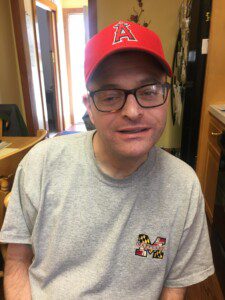 My story began on October 16, 1991. I was at work leaning on my left arm taking a window out of a home. All of a sudden, I got a shot of pain from my left collar bone down my arm and my arm went numb.
My story began on October 16, 1991. I was at work leaning on my left arm taking a window out of a home. All of a sudden, I got a shot of pain from my left collar bone down my arm and my arm went numb.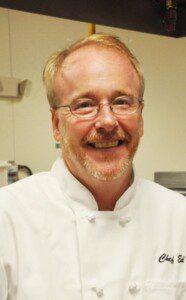 My name is Ed McArdle, a recovering chef with bi-lateral hand pain. The letters CRPS, have only recently been added to my diagnosis and so like many of you my new life journey has begun. My life will change, has changed, and a new perspective on HOW to live is now my new focus.
My name is Ed McArdle, a recovering chef with bi-lateral hand pain. The letters CRPS, have only recently been added to my diagnosis and so like many of you my new life journey has begun. My life will change, has changed, and a new perspective on HOW to live is now my new focus.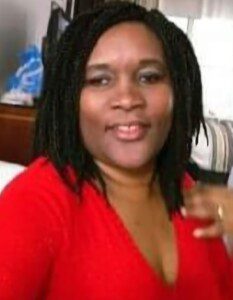 Written by Valrie Ricketts
Written by Valrie Ricketts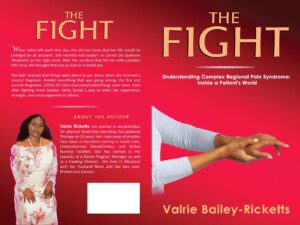
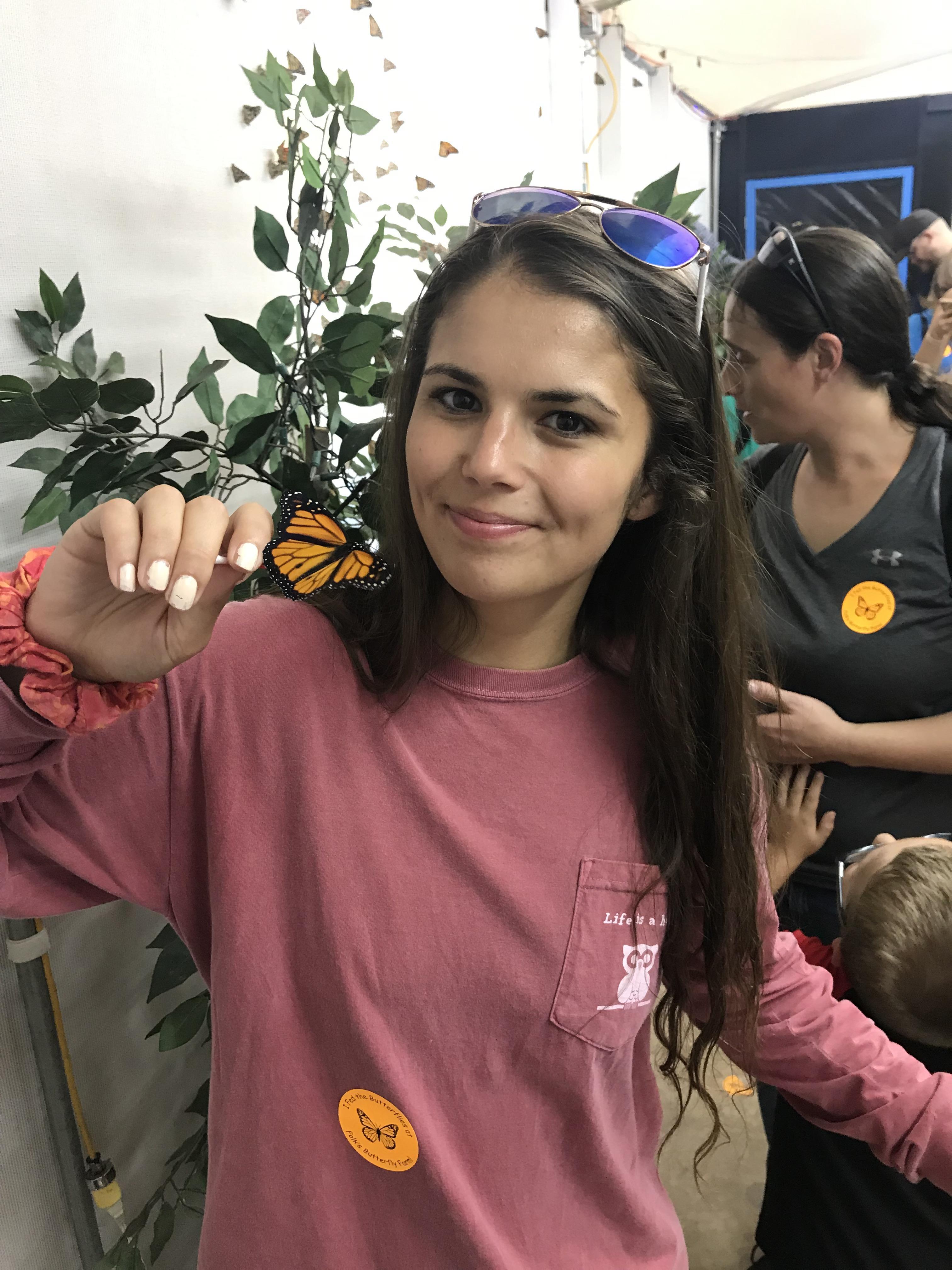 Written by Gianna Harris for the RSDSA blog.
Written by Gianna Harris for the RSDSA blog. The best advice I would give to someone newly diagnosed is, you are not alone. There are others out there that feel the same way as you and the CRPS community has created so many opportunities for you to connect with individuals alike. Check out different Facebook and Instagram pages. Check the RSDSA website to see if there is a
The best advice I would give to someone newly diagnosed is, you are not alone. There are others out there that feel the same way as you and the CRPS community has created so many opportunities for you to connect with individuals alike. Check out different Facebook and Instagram pages. Check the RSDSA website to see if there is a 

